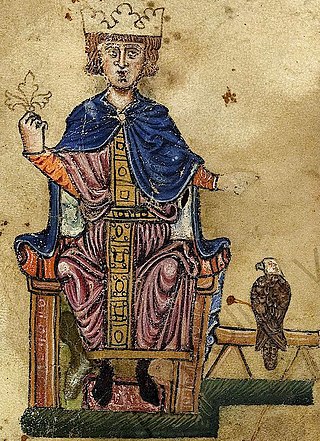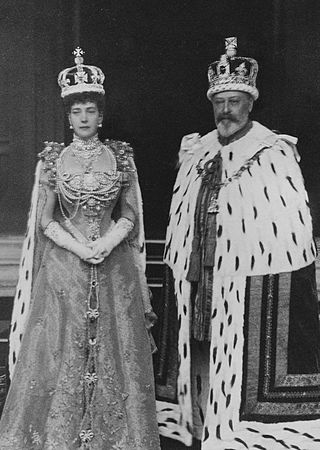Related Research Articles

Alphons is a male given name recorded from the 8th century in the Christian successor states of the Visigothic kingdom in the Iberian peninsula. In the later medieval period it became a standard name in the Hispanic and Portuguese royal families.

The 12th century is the period from 1101 to 1200 in accordance with the Julian calendar. In the history of European culture, this period is considered part of the High Middle Ages and is sometimes called the Age of the Cistercians. The Golden Age of Islam experienced a significant development, particularly in Islamic Spain.
Henry may refer to:

Bhumibol Adulyadej, conferred with the title King Bhumibol the Great in 1987, was the ninth monarch of Thailand from the Chakri dynasty, titled Rama IX. Reigning since 9 June 1946, he was the world's longest-reigning current head of state from the death of Emperor Hirohito of Japan in 1989 until his own death in 2016, and is the third-longest verified reigning sovereign monarch in world history after King Louis XIV and Queen Elizabeth II, reigning for 70 years and 126 days. During his reign, he was served by a total of 30 prime ministers beginning with Pridi Banomyong and ending with Prayut Chan-o-cha.
An heir presumptive is the person entitled to inherit a throne, peerage, or other hereditary honour, but whose position can be displaced by the birth of a person with a better claim to the position in question. This is in contrast to heirs apparent, whose claim on the position cannot be displaced in this manner.
Regnal numbers are ordinal numbers used to distinguish among persons with the same name who held the same office. Most importantly, they are used to distinguish monarchs. An ordinal is the number placed after a monarch's regnal name to differentiate between a number of kings, queens or princes reigning the same territory with the same regnal name.
A queen dowager or dowager queen is a title or status generally held by the widow of a king. In the case of the widow of an emperor, the title of empress dowager is used. Its full meaning is clear from the two words from which it is composed: queen indicates someone who served as queen consort, while dowager indicates a woman continues to hold the title from her deceased husband. A queen mother is a former queen, often a dowager queen, who is the mother of the reigning monarch.
A personal union is the combination of two or more states that have the same monarch while their boundaries, laws, and interests remain distinct. A real union, by contrast, would involve the constituent states being to some extent interlinked, such as by sharing some limited governmental institutions. Unlike the personal union, in a federation and a unitary state, a central (federal) government spanning all member states exists, with the degree of self-governance distinguishing the two. The ruler in a personal union does not need to be a hereditary monarch.

Antonio de Cabezón was a Spanish Renaissance composer and organist. Blind from childhood, he quickly rose to prominence as a performer and was eventually employed by the royal family. He was among the most important composers of his time and the first major Iberian keyboard composer.

Sri Savarindira, also known as Savang Vadhana, was a consort and half-sister of Chulalongkorn, but she was not the Rajini or the highest ranked consort. After her first grandson's accession to power in 1935, she became known as Somdetch Phra Phan Vassa Ayika Chao. All her children died before her, so she lived to see her grandsons Ananda Mahidol and Bhumibol Adulyadej take the throne.

Louis IX of Hesse-Darmstadt was the reigning Landgrave of Hesse-Darmstadt from 1768 to 1790.

In modern heraldry, a royal cypher is a monogram or monogram-like device of a country's reigning sovereign, typically consisting of the initials of the monarch's name and title, sometimes interwoven and often surmounted by a crown. Such a cypher as used by an emperor or empress is called an imperial cypher. In the system used by various Commonwealth realms, the title is abbreviated as 'R' for 'rex' or 'regina'. Previously, 'I' stood for 'imperator' or 'imperatrix' of the Indian Empire.
The term's minority reign and royal minority refer to the period of a sovereign's rule when he or she is legally a minor. Minority reigns are of their nature in times when politicians and advisors can be especially competitive. Some scholars claim that, in Britain, primogeniture, the growth of conciliar government, and the emergence of the Parliament as a representative and administrative force all occurred within the context of the minority reigns.

The Order of the Gold Lion of the House of Nassau is a chivalric order shared by the two branches of the House of Nassau.

Frederick is a masculine given name meaning "peaceful ruler". It is the English form of the German name Friedrich. Its meaning is derived from the Germanic word elements frid, or peace, and ric, meaning "ruler" or "power".

The coronation of Edward VII and his wife, Alexandra, as King and Queen of the United Kingdom and the British Dominions, and as Emperor and Empress of India took place at Westminster Abbey, London, on 9 August 1902. Originally scheduled for 26 June of that year, the ceremony had been postponed at very short notice, because the King had been taken ill with an abdominal abscess that required immediate surgery. In contrast to the previous coronation some 64 years earlier, Edward's had been carefully planned as a spectacle reflecting the influence and culture of the British Empire, then at the height of its power, but also as a meaningful religious occasion.

The coat of arms of Castile was the heraldic emblem of its monarchs. Historian Michel Pastoureau says that the original purpose of heraldic emblems and seals was to facilitate the exercise of power and the identification of the ruler, due to what they offered for achieving these aims. These symbols were associated with the kingdom, and eventually also represented the intangible nature of the national sentiment or sense of belonging to a territory.
References
- ↑ Alfonso X of Castile "Selected Carols"
- ↑ Surrugue, Stéphanie (2010). Enegænger. Politikens Forlag. pp. 339–341. ISBN 978-87-567-8729-1.
- ↑ King Henry VIII, Allmusic.com, "List of compositions of Henry VIII"
- ↑ Frederick the Great, Allmusic.com, "List of compositions of Frederick the Great
- ↑ Crown Prince Naruhito, Mongolia Web, "Crown Prince Naruhito Surprises Audience with Viola Performance in Mongolia", 16 July 2007
- ↑ John IV of Portugal, O Come, All Ye Faithful,
- ↑ King Bhumibol Adulyadej, Bangkok Post, "The Jazzy King" and streaming audio of his jazz compositions at kanchanapisek.or.th